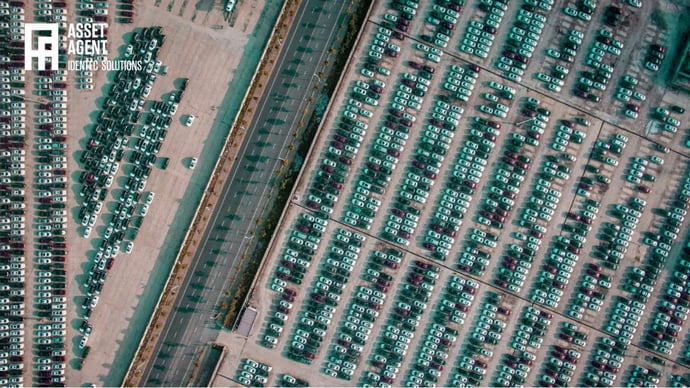Automobile Sector: How RTLS improves production Processes
| Written by Christian Aadal
Digitisation in the automobile sector can eliminate waste and idle time, helping to boost productivity and efficiency in a manufacturing environment.

No video selected
Select a video type in the sidebar.
Digitisation is the magic word in many industries these days. Especially in the automobile sector. Car manufacturers are constantly looking for solutions to improve their processes (like locating vehicles in the production yard). Improvements in these processes include higher efficiency and productivity, more transparency and, of course, higher profits.
Digitisation has arrived in many areas of the automobile sector. The automotive industry is experiencing rapid technological advancements, reshaping the traditional car landscape. Screenification, or the proliferation of screens inside vehicles, is evident in Volkswagen's 38cm screen, Peugeot's Hypersquare, and Stellantis' dual-screen display. Mobility-as-a-Service (MaaS) promises seamless digital environments across vehicles while automakers enhance traffic insights, route optimization, and vehicle reservation capabilities. Collaboration with tech giants like Google and competitors like Tesla is reshaping the competitive landscape, necessitating partnerships or consolidation. Virtual car showrooms, leveraging VR/AR and AI, revolutionize auto sales, offering unparalleled buyer satisfaction. Meanwhile, Shared Mobility & Connectivity Services could generate an additional $1.5 trillion in revenue by 2030 through data-driven on-demand mobility. Growing consumer demand for eco-friendly options has catalyzed the rise of vegan-friendly cars, like the Tesla Model S and Ford Mustang Mach-e, and natural gas-powered vehicles like Scania’s LNG tractor unit, which boasts a 90% CO2 reduction. Adaptive AI facilitates real-time retraining and goal adjustments, enhancing wireless value realization. Collectively, these trends herald a transformative era for the automotive sector, demanding innovation and adaptability (1).
But in production, modern IT infrastructures and technologies like RFID seem to be at the top of my mind. Those technologies made their way into production, warehouses and logistics. However, there are more challenges to be found in the automobile sector. So, let's have a closer look into one of these areas: the process of building a pressing tool.
WHAT ARE THE MAIN CHALLENGES IN TOOL SHOPS?
In one sentence: The main challenge is to reduce manual processes as much as possible and allow flexible automation for a constant and reliable flow. As we know, the main ingredients of (production) processes are machines, materials and labour. As all three must be set up and ready to kick off the production process, the raw materials must be ordered at the beginning of the process. Once you have received the shipment, the material will be put in stock. This is usually supported by barcodes: Material will be scanned, and the shipment will be automatically added to the stock in the customer's ERP or Production Management System. If the shipment is complete – fine. If not, a manual process starts, including contacting the supplier and repeatedly checking the material for an accurate data update. Having all the required material finally on-site, the production of a pressing tool can be started: Carrier and material will be put in place. Well, can the worker be sure that he has the right box of material on-site? Does he start his work at the right tool carrier? All this information must be checked manually before starting the building process.
At this point of production, only basic information and data on the project status are available in the ERP or Production Management System. After finishing this first task, the carrier must be released for the next step and must be moved to another site for final testing and approval. The finished pressing tool will then be handed over to serial production. It's no surprise that these last steps in the process are manual ones, too.
HOW CAN A COMBINED RFID/RTLS SOLUTION HELP?
The main issue for the shown process is intransparency due to missing information. In general, when transparency is lacking, employees aren't getting the right information to do their work, which leads to poor forecasting abilities, a lack of direction and responsibility, and fragmented and inconsistent processes. As a result, companies run massive risks of making errors, losing money, wasting effort, and alienating vendors or customers. On the other hand, when your company runs transparent processes, you can easily make informed decisions, track what is being done within a process, measure team performance and process efficiency, and gain insight into employee, team, and company productivity.
A solution combining RFID (Radio Frequency Identification) and RTLS (Real Time Locating System) technology can benefit the customer's process management. Using wireless technologies eliminates manual work, which always involves a certain amount of insecurity; for instance, a wrong material box has been scanned, or the selected tool carrier was incorrect.
Let's start our tour through the wireless world at the ordering stage again. The supplier of the material will be equipped with an RFID/RTLS transponder (or tag), which can communicate wirelessly with other devices and should also have the option to store some data in its internal data storage. Why is it necessary to have data storage? The idea is that the supplier should store the shipment data on the transponder while preparing the shipment. Each screw, each washer, and each metal part. If the shipment contains bigger parts, each part can be equipped with a transponder (Further reading: RFID for asset tracking).
Once the shipment enters the customer's site, the transponder can be detected by an RFID gate, and the data will be sent immediately to the customer's ERP software. Deficiencies or wrong deliveries can easily be detected, and the appropriate action will be initiated automatically by the ERP software. The material trolleys will then be moved to the tool carrier or will be put on stock. Each trolley still contains the transponder, and since the transponder uses active RFID, it sends its ID in predefined time intervals. The exact position of the trolley can be determined by using RTLS technology. A clear association between the tool carrier and the material trolley can now be made. Of course, each movement of the carrier and/or trolley will be detected and can be made visible on a Client PC as well as on the Server. Simply put, RTLS is an asset tracking system.
Extended reading: Real-time locating system and industry 4.0
NOW, WHAT EXACTLY IS RTLS?
There is no unique definition of an RTLS solution. All those solutions use dedicated hardware and software to determine the position of an object in real time in a predefined area, usually by analysing the communication between the transponder and receiver. It sounds simple, but in fact, it is quite a complex task. You can find diverse approaches – like different frequencies - to achieve a specific desired accuracy in a given environment. Not all of them are suitable for an Automotive environment. When selecting a solution, many topics need to be considered. What might be important? Depending on the environment, devices should be rugged and sealed against the elements. The transponder's battery should have a high battery lifetime, and battery replacement should be easy. And if you think about the future, the solution also should be scalable to be prepared for further extensions.
Do you want to understand RTLS technology? Download our RTLS eBook; no registration is needed!
WHAT NEEDS TO BE CONSIDERED When using RTLS?
There is no one-size-fits-all RFID/RTLS solution for automobile sector tool shops. Each customer has certain requirements for such a solution.
Many factors have to be considered and looked at:
- automation from procurement to production to distribution
- reducing search times for material
- reducing misplacements
- decrease machine idle times
- improve quality, efficiency
- save precious time for workers
But also have a look at these criteria:
- cost
- scalability
- ease of use
- easy to maintain
The expectations are quite universal, independent of how the final solution will look. In a nutshell, it is all about achieving higher efficiency and transparency, which should result in faster processes, higher quality, higher transparency and ultimately, higher profit. Read more about the 14 things to consider when implementing a Real Time Location System.
FAQ on RTLS in the Automobile Production Process
What are the main challenges in tool shops within the automobile sector?
The primary challenge in automobile sector tool shops is to minimise manual processes and enable flexible automation for a steady and reliable workflow. This involves managing the coordination of machines, materials, and labour from the outset of production. Manual processes often begin when discrepancies arise, such as incomplete shipments, requiring additional checks and communication with suppliers. Ensuring the correct materials and tool carriers are in place also demands manual verification, leading to potential inefficiencies and errors.
How can a combined RFID/RTLS solution enhance the production process in the automobile industry?
A combined RFID (Radio Frequency Identification) and RTLS (Real-Time Locating System) solution can significantly increase transparency and efficiency in the production process. This technology enables automatic tracking and verification of materials from the ordering stage through production, reducing manual work and associated errors. For example, as materials enter the production site, their information is immediately updated in the ERP system, enabling quick detection of any discrepancies. Additionally, RTLS technology provides real-time tracking of material trolleys and tool carriers, ensuring accurate and efficient material handling and process flow.
What is RTLS, and what should be considered when implementing it in the automobile sector?
RTLS, or Real-Time Locating System, is a technology used to determine the real-time position of objects within a predefined area. It involves sophisticated hardware and software that analyse communication between transponders and receivers. When implementing RTLS in the automobile sector, considerations include the ruggedness of devices, battery life, ease of battery replacement, scalability for future expansions, and the suitability of different frequencies for the specific environment. The goal is to select a solution that enhances efficiency, reduces material search and misplacement times, decreases machine idle times, and ultimately improves quality and profitability.
Takeaway
This article underscores the transformative impact of digital technologies, particularly RFID and RTLS, in streamlining the production process in the automobile industry. By integrating these technologies, the industry can address its critical challenge of reducing manual processes and increasing automation. These solutions offer enhanced transparency, real-time tracking, and accuracy in managing materials and tools, leading to significant improvements in efficiency and productivity. The implementation of RFID and RTLS not only minimizes errors but also paves the way for better forecasting, decision-making, and process consistency. However, it's crucial to consider factors like the robustness, battery life, and scalability of these systems to ensure they are tailored to the unique demands of the automotive environment. Ultimately, the integration of these digital solutions is a step towards optimizing production workflows, improving quality, and driving higher profits in the automobile sector.
WANT TO LEARN MORE?
Delve deeper into one of our core topics: Real time locating system
Glossary
Radio frequency (RF) refers to the range of electromagnetic wave frequencies used for wireless communication, typically from 3 kHz to 300 GHz. RF is vital for transmitting data in technologies like radio, television, mobile phones, Wi-Fi, and radar. These frequencies enable signal propagation through the air, supporting various communication and sensing applications. RF technology requires careful management of frequency bands to minimize interference and ensure efficient operation.
Sources:
(1) www.templeton-recruitment.com/tech-news/digital-transformation-in-automotive-market-report-2023
(2) Pozar, D. M. (2011). Microwave Engineering (4th ed.). Wiley.
Note: this article was updated on the 13th of January 2025

Author
Christian Aadal, Product Manager
Christian Aadal has several years of experience in the Telecom industry, working for some of the top names in the business. From a technical support engineer to project engineer, Global Product Manager - Asset Agent to sales, Christian prides himself on being able to understand industry needs. His experience in the field gives him the ability to provide solutions for customers that can best meet their requirements and generate the value they are looking for.
Related Articles
Related Product



